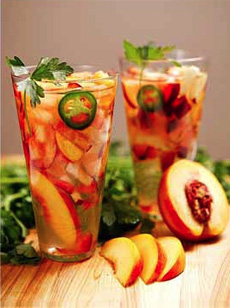TIP OF THE DAY: Fun With Nonalcoholic Beverages
|
|
Many home trends in foods and how to serve them come from restaurants, where chefs are constantly on the look for new ways to tempt customers.
While mixologists have long been creating menus of specialty cocktails, nonalcoholic customized beverages are moving to the foreground as well. In addition to being a money-maker for margin-squeezed restaurants, customers can view these beverages as novel and better for them, tempting some to trade up from tap water. Recently, the National Restaurant Association polled nearly 1,300 chefs about nonalcoholic happenings in their restaurants. The top five answers follow. For us at home, it’s an opportunity to follow the trend and treat family and guests to something special. 1. GOURMET LEMONADE Chefs point to gourmet lemonade as the hottest nonalcoholic beverage trend in restaurants. The “gourmet” aspect usually comes from adding another fruit or an herb (or both: rhubarb basil lemonade, anyone?), via a syrup or preferably, fresh fruit infused with the tea. |
|
|
As fruits come into season, make blueberry, mango, raspberry, stone fruit (nectarine, peach, plum), strawberry and watermelon lemonade. Add herbs like basil, lavender and mint. Add heat with jalapeño slices. For people who want something more potent, add a shot of eau de vie, gin, lemon liqueur (like Limoncello), saké, tequila or vodka (regular or lemon-infused). To start you off, here’s a basic lemonade recipe that you can customize into your signature beverage, plus a recipe for lavender lemonade, made with organic dried lavender. A minor upgrade can turn the ubiquitous liquid refreshment into something special. It was second on the list of trending beverages, both at fine restaurants and chains (Friendly’s offered mango iced tea nd raspberry iced tea as limited-time offers last summer). It’s easy to use flavored syrups, but the best taste comes from infusing the fruit with the hot water and tea. You can also try cold infusion, adding the fruit to the cooled brew tea and letting it infuse overnight in the fridge. Alternatively, you can buy You can buy fruit-flavored tea bags, loose tea or ice tea mixes (mango, passionfruit, peach, raspberry and more); but when peaches are in season, use the fresh fruit. Our local Japanese restaurant makes a celestial lemongrass iced tea (and for what we’ve been spending on two or three glasses each visit, we’d better start brewing our own). We added the syrup from canned lychees to iced tea (yum!) and when fresh lychees arrive in June and July, we’ll be making fresh lychee iced tea. |
||
|
3. HOUSE-MADE SODA One tactic restaurants use to get guests to trade up from water is to offer a soft drink that they can’t get anywhere else. For several years, we’ve been tempted by house-made sodas, both to see what “real” cola and root beer tasted like before their flavors were fixed on our palates by commercial brands; and to experience the new (to us) and different (celery and basil, for example). The easy way to start at home is to get a Sodastream, practice with their syrups and then create your own. Get a recipe book like Homemade Soda, with 200 recipes for making fruit sodas, fizzy juices, flavored sparkling waters, root beer, cola and more. Consumers are increasingly interested in foods that are healthy and sustainable: two words that describe organic products. Organic coffee is a hot trend. Instead of a simple cup of coffee at the end of the meal, some chefs at better restaurants are offering coffee brewed from better beans: organic beans or single-origin beans. |
 Fresh peach iced tea is a treat, but for a kick, add some jalapeño slices (remove the seeds and white pith). Photo courtesy Canard Inc. | NYC. |
|
|
Instead of asking your guests, “Who wants coffee?” you can say, “Who’d like a cup of Blue Moon organic, Rain Forest Alliance coffee from Bali?” Tiny Footprint is a brand that hits the trifecta: Certified Organic, Fair-Trade and part of the Rainforest Alliance, which is carbon negative and replants forests. It’s also delicious coffee (here’s our review). You can buy it online. Americans are now buying some $400 million in coconut water annually. Coconut water is the clear juice of young coconuts, as opposed to opaque white coconut milk, used for Piña Coladas (among other purposes). Here’s more about coconut water. The trendy liquid is sought for its high content of potassium and other nutrients, as well as its relatively low calorie content. It’s drunk straight or added to smoothies. While coconut water is sold in flavors (peach mango, pineapple, etc.), you can flavor your own. Lemon Cayenne, anyone?
|
||



